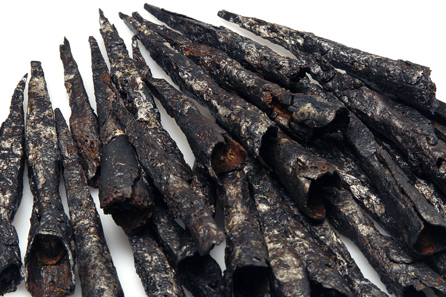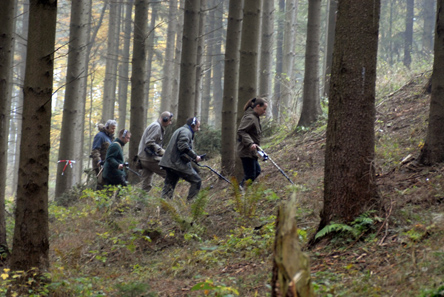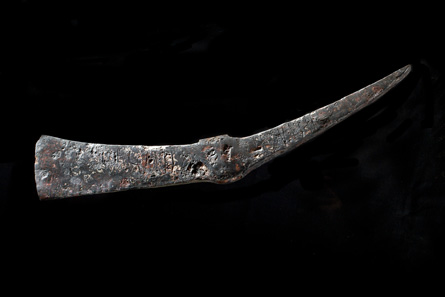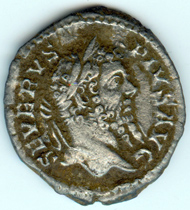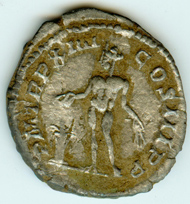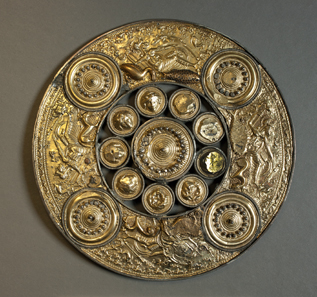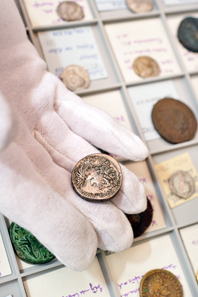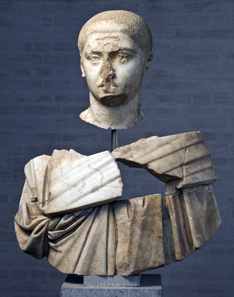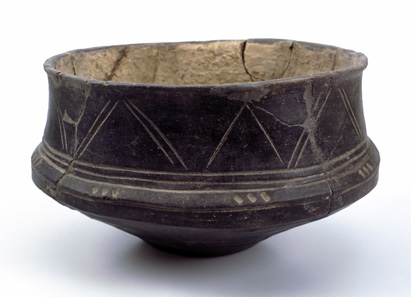October 3, 2013 – The discovery of a roman-German battlefield dating back to the third century at Harzhorn in the hillside area of southern Lower Saxony in 2008 is one of the most important archaeological discoveries of our time. It has caused a re-assessment of the traditional historical image of the relations between the Roman Empire and the Germanic tribal societies in this time horizon. The battlefield event is probably to be identified with the historically conveyed punitive expedition of emperor Maximinus Thrax to the Germanic area in 235.
Heads of catapult bolts. Photo: I. Simon, BLM.
On behalf of the state of Lower Saxony, the Brunswick State Museum has opened the state exhibition ‘Rome’s Forgotten Campaign. The Battle of Harzhorn’ on September 1, 2013. The display will be open until January 19, 2014. The events unveiled are placed into the historical political context of the Roman-German world of the third century in the early phase of the barbarian migration period.
Systematical archaeological survey at Harzhorn. Photo: Christa S. Fuchs, NLD.
In 2008 two hobby archaeologists presented finds from a wooded area at Harzhorn, a range of hills on the western side of the Harz Mountains. The metal items were undisputedly identified as Roman military items – spear and catapult stem, a pioneer spade and an iron hoof sandal. In view of the geographic location of the discovery site, this was indeed an archaeological sensation. Since then more than 2,000 mostly military pieces spread across an area of around 1.4 km have been unearthed.
Dolabra (Roman mattock) bearing the inscription “Leg IIII”. Photo: Th. Deutschmann/NLD.
The range of finds comprises mostly roman items such as weapons, legionnaire equipment, carriage and harness pieces, other accompanying baggage components and coins. This complex shows extracts of the equipment of a Roman army and the wide spectrum of items found confirms the presence of such an army. The Germanic material found, which is far less in terms of quantity, consists mainly of weapons.
Careful mapping and measurement of the items discovered as well as the analysis of their composition prove that Harzhorn was the site of a battle, which up to now had not been known of, between Romans and Germans more than 200 years after the victory of Arminius 9 CE and the campaigns of revenge of Germanicus between 14 and 16 CE.
Marble bust of Maximinus Thrax, 235-238 CE. Photo: Roma, Musei Capitolini Palazzo Nuovo.
Coin finds and natural science examinations enable extraordinarily exact dating of the Harzhorn battle in the time between 227 CE and not long after 240 CE. This means it is very likely that the battle site discovered can be linked to the historically conveyed campaign of revenge of the roman emperor Maximinus Thrax in the year 235 CE. In addition, this new discovery means it is possible and necessary to revise the out-dated historical image of Roman-Germanic relations in the third century. And this is what makes this find such a spectacular discovery.
Coin of emperor Septimus Severus, denarius from 206 CE. Photo: Thorsten Schwarz, Ldkr. Northeim/NLD.
The finds at Harzhorn impressively show that the picture of the campaigns carried out by emperor Maximinus Thrax as provided by the ancient literary sources needs to be revised and reconsidered. Roman advances deep into Germania, whether as a reaction to barbarian invasions or as a preventive measure, can no longer be seen as improbable after the discoveries made at Harzhorn.
One of the very first findings at Harzhorn: a Roman “Hippo-sandal”, a device to protect the mules’ hoof. Photo: I. Simon, BLM.
This Lower Saxony state exhibition presents to a wide public this important national archaeological ‘find of the century,’ the only known Roman-Germanic battlefield of the early Roman emperor period. The presentation places the important ‘Harzhorn finds’ within the context of their time with international and national exhibits and therefore provides the unique opportunity of combining the most significant items of this time horizon in one overall presentation.
Decorative disc of Thorsberg, brass, silver, gilded, 1st half of 3rd century CE. Photo: Archäologisches Landesmuseum Schleswig-Holstein, Schleswig.
The state exhibition at the Brunswick State Museum is executed in cooperation with partners of the working group of Harzhorn which is made up of the Lower Saxony office for the preservation of historic Monuments Hanover, the universities in Osnabrück and Berlin, the Lower Saxony institute for historical coastal research Wilhelmshaven, the historical Museum Frankfurt and the district of Northeim, the town of Gandersheim and the district of Kalefeld.
View on a tetradrachm featuring the portrait of emperor Caracalla. Photo: A. Greiner-Napp.
Historical contents are presented in an interesting and appealing manner using modern, innovative didactic methods. An extensive pedagogic program accompanies the exhibition. Following an introductory section in which the place of discovery and the issues involved in examining the archaeological finds at battlefields are presented, there is a prologue in which the Roman-Germanic relations are described resulting from the Augustan-Tiberic war campaigns through to the events at Harzhorn.
Deliberately destroyed marble bust of emperor Severus Alexander, 235 CE, Staatliche Antikensammlung und Glyptothek, Munich. Photo: Renate Kühling.
At the center of the exhibition are the events of the years around the Germanic campaign of 233 to 238 which are conveyed in story form – a unique opportunity in archaeological communication. The battle is portrayed in real-life form and other interpretations are also provided. The exhibition closes with a perspective of the political effects of the campaign during the period of reign of Maximinus Thrax and the resultant historical development through to the fall of Limes around 260 …
Germanic urn from the ‘Ole Hai’ (Old Grove) nearby Lelm-Räbke in the Elm, 3rd century. Photo: Braunschweigisches Landesmuseum.
… as well with as with a comparison of the different funerary rites of Romans and Germanic tribes.
Significant loans from Europe, the USA and the Middle East were given for this exhibition project and allow to reconstruct the finds from Harzhorn, to illustrate the event and to place it in a national historical context.
You can find detailed information on the State exhibition on the website of the Brunswick State Museum.
Many video clips are available on Youtube. You can find films regarding the excavation, …
… a documentary of the battle and the archaeological site, …
… the fighting technique of the legionnaires …
… and a demonstration of a reconstructed ballista, a very effective Roman missile weapon.




